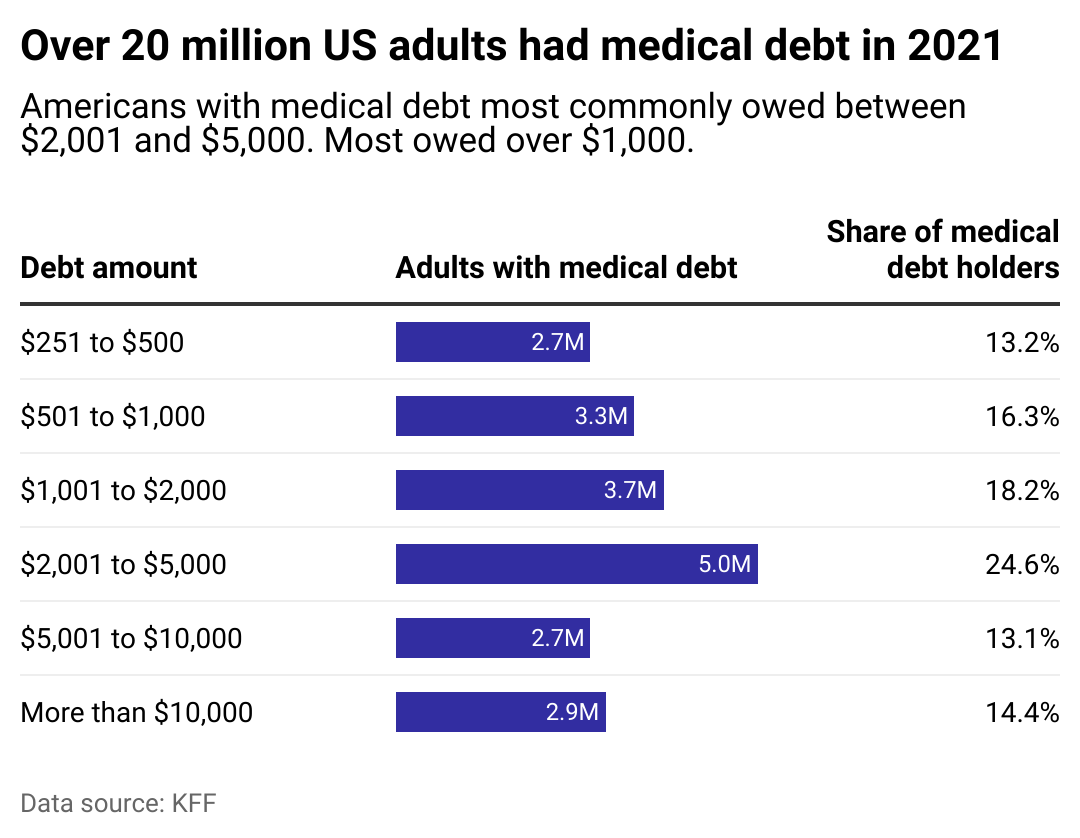How medical debt drives half a million people into bankruptcy each year

Shutterstock // fizkes
How medical debt drives half a million people into bankruptcy each year
An older woman looking at the sheet of paper in her hand looking distressed and concerned.
The devastating financial toll of paying for urgent medical costs can take years or even a lifetime for some families to recover from.
Set your browser to gofundme.com, and chances are the first donor cause you see will be someone asking for help to pay their medical bills. Around a third of campaigns on the crowdfunding platform are for medical bills. In some ways, this is unsurprising: Health care is extremely expensive in America. Data compiled by the Organization for Economic Cooperation and Development show that after adjusting for local costs, the United States spent around $12,500 per person on health care in 2022, double what Canada spent and around 50% more than what Germany spent.
These costs add up quickly. About 3 out of 5 personal bankruptcies in America are associated with medical debt. Doctors and Clinicians analyzed reports and survey data to determine how medical debt is contributing to America’s personal bankruptcy problem.
A 2019 study in the American Journal of Public Health found this proportion held, even after the Affordable Care Act drastically increased health insurance coverage. The study estimates that around 530,000 Americans file bankruptcy every year because of medical bills or illness-related work loss.
Research from the Consumer Financial Protection Bureau finds that as of 2021, 58% of debt in collections was related to medical bills. The next most common form of debt in collections, telecommunications bills, only made up 15% of the total.
![]()

Doctors and Clinicians
Just how widespread is medical debt?
A chart showing how much medical debt Americans have. Among those who have medical debt, most owe at least $1,000.
Figuring out just how many Americans have medical debt is tricky. No singular database exists on the topic, so researchers have to rely on survey data. One estimate from the Census Bureau found that roughly 15% of households had at least some medical debt in 2021. Using the same dataset, KFF estimates that around 8% of American adults had medical debt in 2021. Overall, people in the U.S. had a total of $220 billion in medical debts.
These estimates lean conservative, counting only medical bills and not other forms of debt such as credit card bills. In a separate analysis, which included credit card bills resulting from medical procedures, KFF estimates that around 40% of American adults have some form of medical debt, or 100 million people.
While it may be unclear exactly how big America’s medical debt problem is, surveys show consistent patterns when it comes to what groups of people are most likely to have unpaid medical bills. People with lower incomes, for instance, are more likely to report having medical debt. Around 11% of people who earn up to twice the federal poverty line have medical debt, compared with only 4% of people who make over six times the federal poverty line. Similarly, adults who lack health insurance for part of the year or the whole year are more likely to have unpaid medical bills.
It is also clear that people with high amounts of medical debt are more likely to have to make sacrifices to make their finances work. The KFF survey reports that among American adults with medical debt, 63% say they have had to cut spending on essentials such as food and clothing, while 48% say they have used up all or most of their savings. A study published in JAMA Psychiatry found that medical debt was associated with higher rates of depression and anxiety. People with medical debt were also more likely to delay mental health treatment, further exacerbating the problem.

Canva
Governments are working to relieve medical debt
An elderly Asian couple is looking worried while sitting on a couch. There is a laptop on a coffee table, and the woman is holding a white square device, showing it to the man next to her.
As part of the American Rescue Plan, the White House intends to pay off $7 billion in medical debt by the end of 2026. State and local governments have also implemented similar plans. In January, New York City announced that it would relieve $2 billion of unpaid medical bills in conjunction with nonprofit organization Undue Medical Debt (formerly RIP Medical Debt).
As part of a continuing effort to offer relief, the White House announced a proposal to prevent medical debt from showing up on credit reports. This would, in theory, help ensure that people with medical debt are able to access housing, secure car loans, or even find jobs.
Programs such as these should help people in theory. However, a recent National Bureau of Economic Research working paper found that relieving medical debt might not benefit people as much as policymakers might hope. A group of four researchers also partnered with Undue Medical Debt to track how well people did after being relieved of their medical debt. The nonprofit group paid off debt worth around $169 million for over 83,000 people from 2018 through 2020.
Unexpectedly, the authors found that debt relief did not affect people’s access to credit. People who benefited from the study did not go on to have better finances, nor did their mental health improve. One thing the paper did show was that people who had their medical debt paid off were actually slightly less likely to pay subsequent medical bills.
It is possible that just paying off medical bills is not enough to substantially improve the lives of people who could not afford them to begin with. In an interview with Stanford University, one of the study’s authors, Neale Mahoney, explained his research by describing medical debt as a symptom of people’s problems and not an underlying cause.
Story editing by Carren Jao. Additional editing by Kelly Glass. Copy editing by Tim Bruns.
This story originally appeared on Doctors and Clinicians and was produced and distributed in partnership with Stacker Studio.